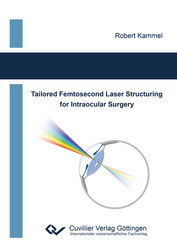| Fachbereiche | |
|---|---|
| Buchreihen (96) |
1378
|
| Nachhaltigkeit |
3
|
| Gesundheitswesen |
1
|
| Geisteswissenschaften |
2364
|
| Naturwissenschaften |
5406
|
| Mathematik | 229 |
| Informatik | 319 |
| Physik | 980 |
| Chemie | 1363 |
| Geowissenschaften | 131 |
| Humanmedizin | 243 |
| Zahn-, Mund- und Kieferheilkunde | 10 |
| Veterinärmedizin | 108 |
| Pharmazie | 147 |
| Biologie | 835 |
| Biochemie, Molekularbiologie, Gentechnologie | 121 |
| Biophysik | 25 |
| Ernährungs- und Haushaltswissenschaften | 45 |
| Land- und Agrarwissenschaften | 1004 |
| Forstwissenschaften | 201 |
| Gartenbauwissenschaft | 20 |
| Umweltforschung, Ökologie und Landespflege | 148 |
| Ingenieurwissenschaften |
1793
|
| Allgemein |
98
|
|
Leitlinien Unfallchirurgie
5. Auflage bestellen |
|
Erweiterte Suche
Tailored Femtosecond Laser Structuring for Intraocular Surgery
Robert Kammel (Autor)Vorschau
Inhaltsverzeichnis, PDF (47 KB)
Leseprobe, PDF (200 KB)
Focused ultrashort femtosecond (fs) laser pulses enable precise surgery in the bulk of transparent ocular tissue without the need of surgically opening the eyeball. Thus, various innovative treatment approaches aim at applying minimally invasive intraocular cuts into the crystalline lens or the vitreous body, e.g., to provide long-lasting therapies for age-related impairments such as presbyopia or retinal detachments. However, side effects such as unwanted tissue responses, reduced quality of vision or detrimental nonlinear pulse-tissue interactions might impair those intraocular fs-laser treatments and could hamper a clinical application.
In this thesis, the side effects of intraocular fs-laser treatments are thoroughly examined and reduced for the first time. In order to rule out adverse tissue responses, the temporal evolution of fs-laser modifications applied to the crystalline lens is investigated initially in an adapted animal trial. Since intraocular fs-laser surgery commonly requires the application of extended modification distributions potentially inducing scattering and diffraction, their influence onto the objective and subjective quality of vision is studied by means of an artificial model eye and a clinical trial based on fs-laser treated contact lenses. Finally, simultaneous spatial and temporal focusing is investigated as a tool to decrease detrimental nonlinear pulse-tissue interactions and to enhance the surgical precision for safe and reliable future intraocular fs-laser treatments.
| ISBN-13 (Printausgabe) | 9783954049554 |
| ISBN-13 (E-Book) | 9783736949553 |
| Buchendformat | A5 |
| Sprache | Englisch |
| Seitenanzahl | 140 |
| Umschlagkaschierung | matt |
| Auflage | 1. Aufl. |
| Erscheinungsort | Göttingen |
| Promotionsort | Jena |
| Erscheinungsdatum | 09.04.2015 |
| Allgemeine Einordnung | Dissertation |
| Fachbereiche |
Physik
Physik der kondensierten Materie (einschließlich Festkörperphysik, Optik) Augenheilkunde |
| Schlagwörter | Physics, Optics, Intraocular fs-Laser Surgery, Laser-induced Optical Breakdown, Materials Processing, Physik, Optik, Intraokulare fs-Laser Chirugie, Laser-induzierter optischer Durchbruch, Materialbearbeitung |








